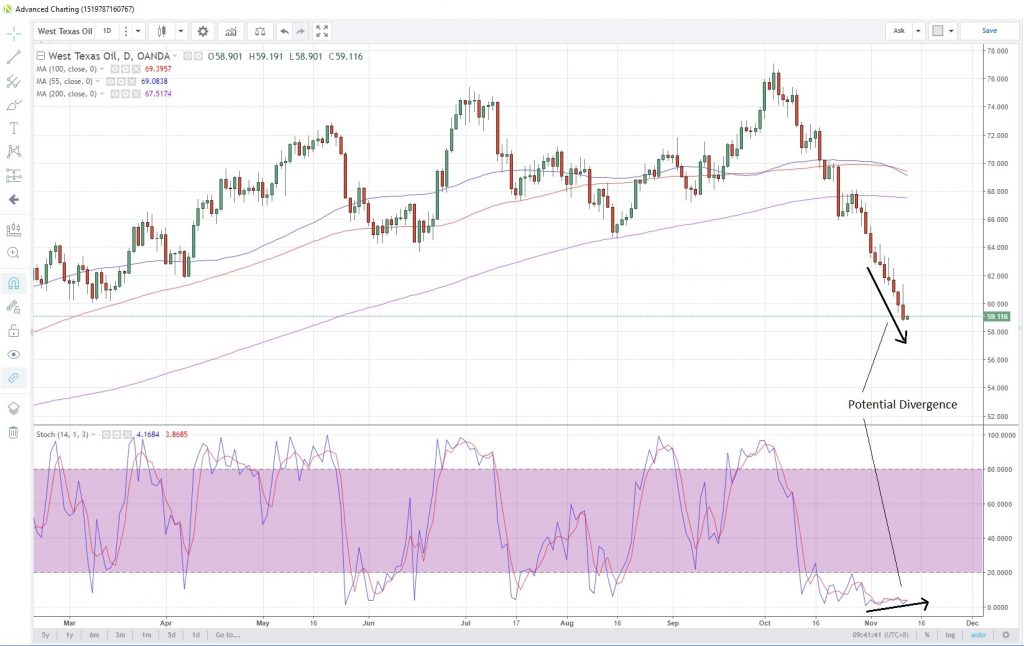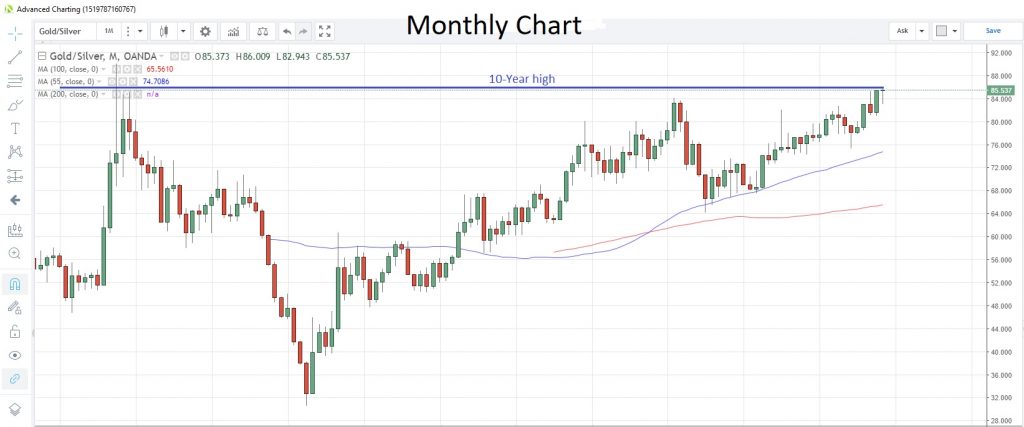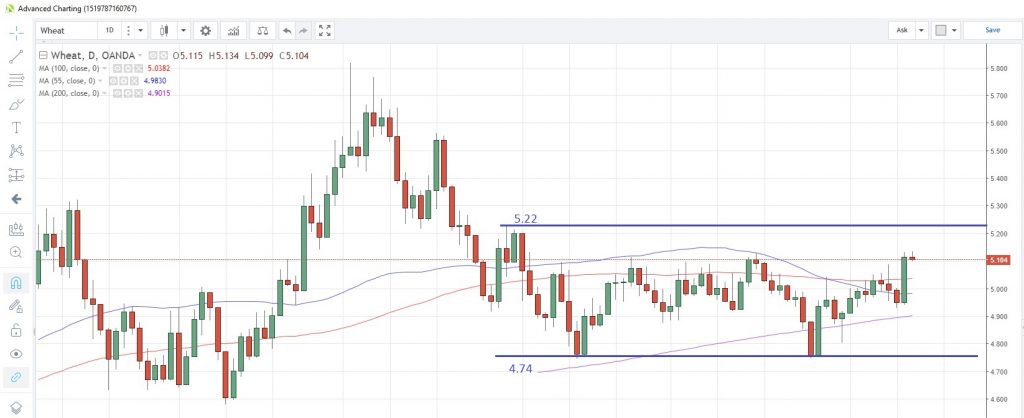
Oil prices struggled to gain a foothold despite OPEC plans to cut production. Metals suffered following the reiterated hawkish rate stance from the Fed last week, which pushed the US dollar to a 16-month peak. The agricultural sector is supported by bad weather hampering harvests but capped by rising stockpiles.
Energy
CRUDE OIL touched the lowest in almost nine months yesterday, despite weekend comments that Saudi Arabia plans to reduce crude oil production by 500,000 barrels per day in December, and OPEC+ plans to trim oil supply going in to 2019. Oil attempted a rebound yesterday but that proved short-lived, and the commodity fell for an 11th straight day.
WTI is making another attempt at a rebound this morning and, if it clings on to gains by close, would halt the 11-day losing streak. Such a move could also set up a bullish divergence pattern on the daily momentum charts, which would suggest the rebound could then have further to run.
WTI Daily Chart
NATURAL GAS saw its biggest weekly gain in four years last week, and has extended the advance into this week, touching 3.930 so far, the highest since December 2014. Forecasts for frigid temperatures in the eastern US this week is driving gains, while gas stockpiles have been falling for four of the last five weeks, according to EIA data.
Natural gas is expected to overtake coal as the world’s second largest energy source after oil by 2030, according to a report from the Paris-based International Energy Agency (IEA) today. Efforts to reduce air pollution and the rise in liquefied natural gas (LNG) use are responsible for the shift, the report says. It also sees global gas demand increasing by 1.6% a year to 2040, and would be 45% higher by then than today.
Precious metals
GOLD has given back about 70% of October’s gains this month, as the US dollar reasserts its authority as the safe haven to go to. Gold looks set to rise today for the first time in seven days after touching the lowest in one month yesterday.
Despite the decline, holdings in gold-backed ETFs have risen for five straight weeks, while speculative accounts added to their net long futures positions by 5,832 contracts in the week to November 6, the latest data snapshot released Friday by CFTC shows.
SILVER is hovering near two-month lows amid the dollar’s onslaught. Bearish bets by speculative investors have fallen to their lowest since the week of August 14, according to the latest data from CFTC as of November 6. The gold/silver (Mint) ratio touched the highest in a decade yesterday, but is facing its first down-day in four days today.
Gold/Silver (Mint) Ratio Monthly Chart
PLATINUM failed to challenge the 200-day moving average at 877.92 last week, and has been falling for the past three days. Today looks as if it could be an up-day, breaking that streak. Convergence of the 100- and 55-day moving averages at 823.71 and 824.69, respectively, would act as the next support level.
Speculative accounts added to their net long positions for a second straight week to November 6, bringing total net longs to the highest since the week of March 27, latest CFTC data shows.
PALLADIUM continues to see two-way trading after hitting a record high of 1,152 last month. It looks set for its first gains in four days and is currently at 1,106.50. It would appear that speculative investors feel there could be more upside beckoning, as they added to net longs in the week to November 6, recouping most of the previous week’s reduction. Net long positioning is back near its highest since the week of June 12.
Base metals
COPPER has given back almost all of the gains made at the start of the month as a hawkish Fed raises questions about global demand for industrial metals, going forward. The metal touched the lowest since November 1 earlier this morning, but has since rebounded and is marginally in the black at 2.6602. Resistance may be found at the 55-day moving average at 2.7094 with the 100-day moving average above at 2.7288. Copper is currently trading at 2.6692.
Agriculturals
SUGAR managed to hold above the 200-day moving average at 0.1186 yesterday, having traded above it since October 8. The commodity has rebounded today and is now trading higher at 0.1225.
Persistent dry weather and pest attacks on India’s sugar crop has meant that output this year will be lower than last year’s record, Bloomberg reports. Looking ahead, India plans to start raw sugar exports direct to China in 2019, while Indonesia has said its output in 2019 will likely increase to 2.5m tons from 2.25m tons this year, a jump of about 11%.
WHEAT prices rose the most in 2-1/2 months yesterday on hopes of a pickup in global demand soon. However, prices are still stuck in the 4.74 to 5.22 trading band, which has contained prices since late-August. The up-move also coincided with reports that rains in eastern and central-west districts in the US is slowing the harvest, though this may just be a short-term effect as drier weather is forecast, enabling a catch-up in harvesting. Looking ahead to the next harvest, winter wheat planting in Kansas has been delayed due to heavy rain.
To keep a lid on prices, the latest World Agricultural Supply and Demand Estimates (WASDE) report from the US Department of Agriculture has increased the forecast for wheat reserves by 2-1/2 times.
Wheat Daily Chart
In the same report, the forecast for CORN stockpiles has been doubled, after China adjusted recent production statistics. However, the report did note that the vast majority of this output would not make its way into global markets. China’s National Grain and Oil Information Centre has predicted that the country’s corn consumption would increase in the year starting from October 1.
SOYBEANS have consolidated at higher levels in the past week on hopes that, now the US midterm elections are over, there may be an easing of tensions in the US-China trade war. There are hopes that the two leaders will sit down together to discuss the matter at a G-20 meeting scheduled toward the end of this month.
As the tariff wars ore ongoing, the USDA has predicted the largest soybean crop ever this year and, with outlet avenues reducing due to tariffs, stockpiles and reserves are likely to increase. Soybeans are trading at 8.725 with the 100-day moving average offering support at 8.5331.




